A Structure-Activity Relationship Comparison of Imidazodiazepines Binding at Kappa, Mu, and Delta Opioid Receptors and the GABAA Receptor
Abstract
1. Introduction
2. Results
3. Discussion
4. Materials and Methods
4.1. Synthesis
4.2. Radioligand Binding Assays
4.3. BRET Assay
4.4. Docking
5. Conclusions
6. Patents
Author Contributions
Funding
Acknowledgments
Conflicts of Interest
References
- Pasternak, G.W.; Pan, Y.X. Mu opioids and their receptors: Evolution of a concept. Pharmacol. Rev. 2013, 65, 1257–1317. [Google Scholar] [CrossRef]
- Lanlanne, L.; Ayranci, G.; Kieffer, B.L.; Lutz, P.-E. The kappa opioid receptor: From addiction to depression, and back. Front. Psychiatry 2014, 5, 1–17. [Google Scholar]
- Kivell, B.; Prisinzano, T.E. Kappa opioids and the modulation of pain. Psychopharmacology 2010, 210, 109–119. [Google Scholar] [CrossRef] [PubMed]
- Cahill, C.M.; Taylor, A.M.; Cook, C.; Ong, E.; Moron, J.A.; Evans, C.J. Does the kappa opioid receptor system contribute to pain aversion? Front. Pharmacol. 2014, 5, 253. [Google Scholar] [CrossRef] [PubMed]
- Kenakin, T.; Christopoulos, A. Signalling bias in new drug discovery: Detection, quantification and therapeutic impact. Nat. Rev. Drug Discov. 2013, 12, 205–216. [Google Scholar] [CrossRef] [PubMed]
- Dogra, S.; Yadav, P.N. Biased agonism at kappa opioid receptors: Implication in pain and mood disorders. Eur. J. Pharmacol. 2015, 763, 184–190. [Google Scholar] [CrossRef]
- Spetea, M.; Eans, S.O.; Ganno, M.L.; Lantero, A.; Mairegger, M.; Toll, L.; Schmidhammer, H.; McLaughlin, J.P. Selective kappa receptor partial agonist HS666 produces potent antinociception without inducing aversion after i.c.v. administration in mice. Br. J. Pharmacol. 2017, 174, 2444–2456. [Google Scholar] [CrossRef]
- Hedegaard, H.; Warner, M.; Minino, A.M. Drug overdose deaths in the United States, 1999–2016. NCHS Data Brief 2017, 294, 1–8. [Google Scholar]
- van Hecke, O.; Austin, S.K.; Khan, R.A.; Smith, B.H.; Torrance, N. Neuropathic pain in the general population: A systematic review of epidemiological studies. Pain 2014, 155, 654–662. [Google Scholar] [CrossRef]
- Nieman, A.N.; Li, G.; Zahn, N.M.; Mian, M.Y.; Mikulsky, B.N.; Hoffman, D.A.; Wilcox, T.M.; Kehoe, A.S.; Luecke, I.W.; Poe, M.M.; et al. Targeting nitric oxide production in microglia with novel imidazodiazepines for nonsedative pain treatment. ACS Chem. Neurosci. 2020, 11, 2019–2030. [Google Scholar] [CrossRef]
- Machelska, H.; Celik, M.O. Recent advances in understanding neuropathic pain: Glia, sex differences, and epigenetics. F1000Research 2016, 5, 2743. [Google Scholar] [CrossRef] [PubMed]
- Popiolek-Barczyk, K.; Mika, J. Targeting the microglial signaling pathways: New insights in the modulation of neuropathic pain. Curr. Med. Chem. 2016, 23, 2908–2928. [Google Scholar] [CrossRef] [PubMed]
- Kettenmann, H.; Hanisch, U.K.; Noda, M.; Verkhratsky, A. Physiology of microglia. Physiol. Rev. 2011, 91, 461–553. [Google Scholar] [CrossRef] [PubMed]
- Holthusen, H.; Arndt, J.O. Nitric oxide evokes pain in humans on intracutaneous injection. Neurosci. Lett. 1994, 165, 71–74. [Google Scholar] [CrossRef]
- Levy, D.; Zochodne, D.W. NO pain: Potential roles of nitric oxide in neuropathic pain. Pain Pract. Off. J. World Inst. Pain 2004, 4, 11–18. [Google Scholar] [CrossRef]
- Besnard, J.; Ruda, G.F.; Setola, V.; Abecassis, K.; Rodriguiz, R.M.; Huang, X.P.; Norval, S.; Sassano, M.F.; Shin, A.I.; Webster, L.A.; et al. Automated design of ligands to polypharmacological profiles. Nature 2012, 492, 215–220. [Google Scholar] [CrossRef]
- Im, W.B.; Pregenzer, J.F.; Thomsen, D.R. Effects of GABA and various allosteric ligands on TBPS binding to cloned rat GABA(A) receptor subtypes. Br. J. Pharmacol. 1994, 112, 1025–1030. [Google Scholar] [CrossRef]
- Liu, J.; Chen, T.; Norris, T.; Knappenberger, K.; Huston, J.; Wood, M.; Bostwick, R. A high-throughput functional assay for characterization of gamma-aminobutyric acid(A) channel modulators using cryopreserved transiently transfected cells. Assay Drug Dev. Technol. 2008, 6, 781–786. [Google Scholar] [CrossRef]
- Sur, C.; Quirk, K.; Dewar, D.; Atack, J.; McKernan, R. Rat and human hippocampal alpha5 subunit-containing gamma-aminobutyric AcidA receptors have alpha5 beta3 gamma2 pharmacological characteristics. Mol. Pharmacol. 1998, 54, 928–933. [Google Scholar] [CrossRef]
- Hauser, C.A.; Wetzel, C.H.; Berning, B.; Gerner, F.M.; Rupprecht, R. Flunitrazepam has an inverse agonistic effect on recombinant alpha6beta2gamma2-GABAA receptors via a flunitrazepam-binding site. J. Biol. Chem. 1997, 272, 11723–11727. [Google Scholar] [CrossRef]
- Chuang, S.H.; Reddy, D.S. Genetic and molecular regulation of extrasynaptic GABA-A receptors in the Brain: Therapeutic insights for epilepsy. J. Pharmacol. Exp. Ther. 2018, 364, 180–197. [Google Scholar] [CrossRef] [PubMed]
- Jahan, R.; Stephen, M.R.; Forkuo, G.S.; Kodali, R.; Guthrie, M.L.; Nieman, A.N.; Yuan, N.Y.; Zahn, N.M.; Poe, M.M.; Li, G.; et al. Optimization of substituted imidazobenzodiazepines as novel asthma treatments. Eur. J. Med. Chem. 2017, 126, 550–560. [Google Scholar] [CrossRef] [PubMed]
- Forkuo, G.S.; Guthrie, M.L.; Yuan, N.Y.; Nieman, A.N.; Kodali, R.; Jahan, R.; Stephen, M.R.; Yocum, G.T.; Treven, M.; Poe, M.M.; et al. Development of GABAA receptor subtype-selective imidazobenzodiazepines as novel asthma treatments. Mol. Pharm. 2016, 13, 2026–2038. [Google Scholar] [CrossRef] [PubMed]
- Forkuo, G.S.; Nieman, A.N.; Yuan, N.Y.; Kodali, R.; Yu, O.B.; Zahn, N.M.; Jahan, R.; Li, G.; Stephen, M.R.; Guthrie, M.L.; et al. Alleviation of multiple asthmatic pathologic features with orally available and subtype selective GABAA receptor modulators. Mol. Pharm. 2017, 14, 2088–2098. [Google Scholar] [CrossRef]
- Cook, J.M.; Zhou, H.; Huang, S.; Sarma, P.V.V.S.; Zhang, C. Sterospecific Anxiolytic and Anticonvulsant Agent with Reduced Muscle-Relaxant Sedative Hypnotic and Ataxic Effects. U.S. Patent US7618958, 30 June 2005. [Google Scholar]
- Olsen, R.H.J.; DiBerto, J.F.; English, J.G.; Glaudin, A.M.; Krumm, B.E.; Slocum, S.T.; Che, T.; Gavin, A.C.; McCorvy, J.D.; Roth, B.L.; et al. TRUPATH, an open-source biosensor platform for interrogating the GPCR transducerome. Nat. Chem. Biol. 2020, 16, 841–849. [Google Scholar] [CrossRef]
- Che, T.; Majumdar, S.; Zaidi, S.A.; Ondachi, P.; McCorvy, J.D.; Wang, S.; Mosier, P.D.; Uprety, R.; Vardy, E.; Krumm, B.E.; et al. Structure of the nanobody-stabilized active state of the kappa opioid receptor. Cell 2018, 172, 55–67. [Google Scholar] [CrossRef]
- Linclau, B.; Peron, F.; Bogdan, E.; Wells, N.; Wang, Z.; Compain, G.; Fontenelle, C.Q.; Galland, N.; Le Questel, J.Y.; Graton, J. Intramolecular ohfluorine hydrogen bonding in saturated, acyclic fluorohydrins: The gamma-fluoropropanol motif. Chemistry (Easton) 2015, 21, 17808–17816. [Google Scholar]
- Bettinger, H.F. How good is fluorine as a hydrogen-bond acceptor in fluorinated single-walled carbon nanotubes? Chemphyschem 2005, 6, 1169–1174. [Google Scholar] [CrossRef]
- Tortella, F.C.; Robles, L.; Holaday, J.W. U50,488, a highly selective kappa opioid: Anticonvulsant profile in rats. J. Pharmacol. Exp. Ther. 1986, 237, 49–53. [Google Scholar]
- Vardy, E.; Mosier, P.D.; Frankowski, K.J.; Wu, H.; Katritch, V.; Westkaemper, R.B.; Aube, J.; Stevens, R.C.; Roth, B.L. Chemotype-Selective modes of action of kappa-opioid receptor agonists. J. Biol. Chem. 2013, 288, 34470–34483. [Google Scholar] [CrossRef]
- Katritch, V.; Cherezov, V.; Stevens, R.C. Structure-Function of the G protein-coupled receptor superfamily. Annu. Rev. Pharmacol. Toxicol. 2013, 53, 531–556. [Google Scholar] [CrossRef] [PubMed]
- Savic, M.M.; Huang, S.; Furtmuller, R.; Clayton, T.; Huck, S.; Obradovic, D.I.; Ugresic, N.D.; Sieghart, W.; Bokonjic, D.R.; Cook, J.M. Are GABAA receptors containing alpha5 subunits contributing to the sedative properties of benzodiazepine site agonists? Neuropsychopharmacology 2008, 33, 332–339. [Google Scholar] [CrossRef] [PubMed]
- Witkin, J.M.; Cerne, R.; Davis, P.G.; Freeman, K.B.; do Carmo, J.M.; Rowlett, J.K.; Methuku, K.R.; Okun, A.; Gleason, S.D.; Li, X.; et al. The alpha2,3-selective potentiator of GABAA receptors, KRM-II-81, reduces nociceptive-associated behaviors induced by formalin and spinal nerve ligation in rats. Pharmacol. Biochem. Behav. 2019, 180, 22–31. [Google Scholar] [CrossRef] [PubMed]
- Fischer, B.D.; Schlitt, R.J.; Hamade, B.Z.; Rehman, S.; Ernst, M.; Poe, M.M.; Li, G.; Kodali, R.; Arnold, L.A.; Cook, J.M. Pharmacological and antihyperalgesic properties of the novel alpha2/3 preferring GABAA receptor ligand MP-III-024. Brain Res. Bull. 2017, 131, 62–69. [Google Scholar] [CrossRef] [PubMed]
- Brust, T.F.; Morgenweck, J.; Kim, S.A.; Rose, J.H.; Locke, J.L.; Schmid, C.L.; Zhou, L.; Stahl, E.L.; Cameron, M.D.; Scarry, S.M.; et al. Biased agonists of the kappa opioid receptor suppress pain and itch without causing sedation or dysphoria. Sci. Signal. 2016, 9, ra117. [Google Scholar] [CrossRef]
- Witkin, J.M.; Ping, X.; Cerne, R.; Mouser, C.; Jin, X.; Hobbs, J.; Tiruveedhula, V.; Li, G.; Jahan, R.; Rashid, F.; et al. The value of human epileptic tissue in the characterization and development of novel antiepileptic drugs: The example of CERC-611 and KRM-II-81. Brain Res. 2019, 1722, 146356. [Google Scholar] [CrossRef]
- Forkuo, G.S.; Nieman, A.N.; Kodali, R.; Zahn, N.M.; Li, G.; Rashid Roni, M.S.; Stephen, M.R.; Harris, T.W.; Jahan, R.; Guthrie, M.L.; et al. A novel orally available asthma drug candidate that reduces smooth muscle constriction and inflammation by targeting GABAA receptors in the lung. Mol. Pharm. 2018, 15, 1766–1777. [Google Scholar] [CrossRef]
- Li, G.; Stephen, M.R.; Kodali, R.; Zahn, N.M.; Poe, M.M.; Tiruveedhula, V.P.B.; Huber, A.T.; Schussman, M.K.; Qualmann, K.; Panhans, C.M.; et al. Synthesis of chiral GABAA receptor subtype selective ligands as potential agents to treat schizophrenia as well as depression. Arkivoc 2018, 4, 158. [Google Scholar] [CrossRef]
- Li, G. Design and synthesis of achiral and chiral imidazodiazepine (IMDZ) GABA(A)R subtype selective ligands for the treatment of CNS disorders, as well as Asthma. Ph.D. Thesis, University of Wisconsin Milwaukee, Milwaukee, WI, USA, 2019. [Google Scholar]
- Cook, J.M.; Li, G.; Poe, M.M.; Savic, M.M.; Sibille, E. Treatment of Cognitive and Mood Symptoms in Neurodegenerative and Neuropsychiatric Disorders with Alpha5-Containing Gabaa Receptor Agonists. U.S. Patent WO2017161370, 20 March 2017. [Google Scholar]
- Cook, J.M.; Poe, M.M.; Methuku, K.R.; Li, G. Gabaergic Ligands and Their Uses. WO Patent WO2016154031A, 29 September 2016. [Google Scholar]
- Roth, B. National institute of mental health psychoactive drug screening program. In Assay Protocol Book; Department of Pharmacology, University of North Carolina at Chapel Hill: Chapel Hill, NC, USA, 2018; p. 359. [Google Scholar]
Sample Availability: Not available. |

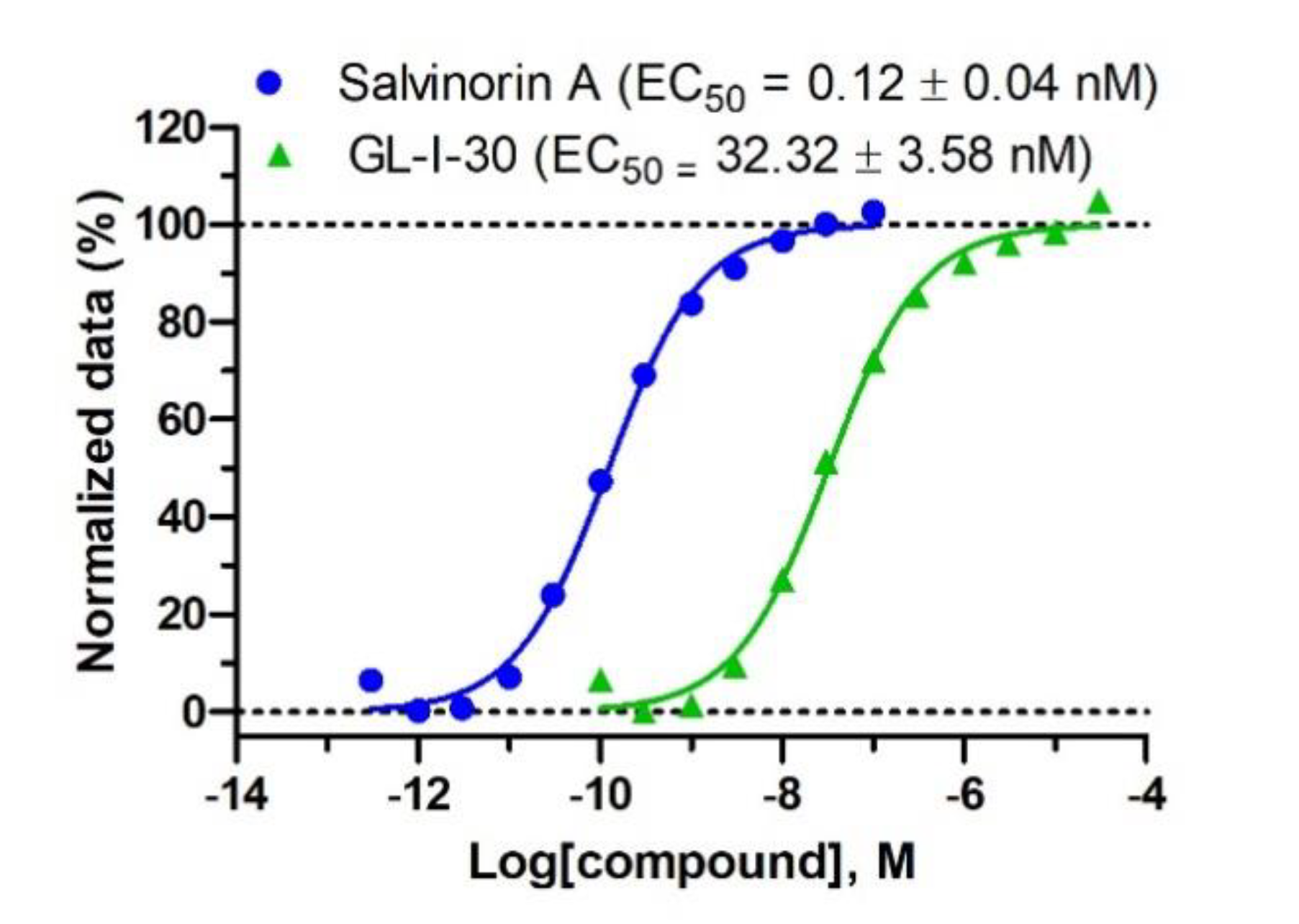
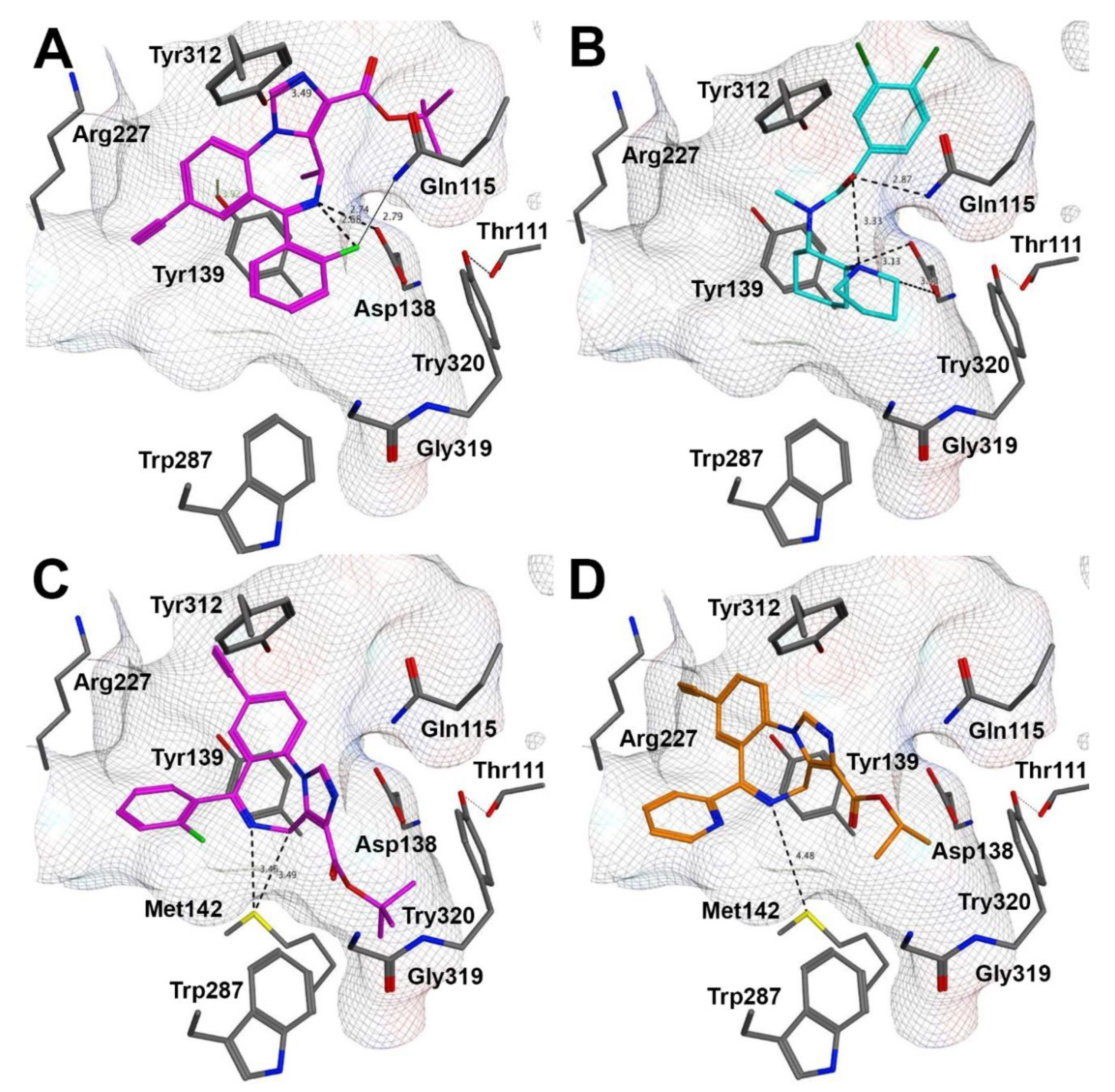
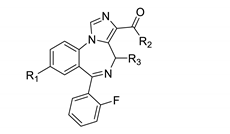
| Entry | Compound | R1 | R2 | R3 CH3 | KOR % 1 | MOR % 1 | DOR % 1 | BZR % 1 |
KOR (Ki, nM) |
BZR (Ki, nM) |
|---|---|---|---|---|---|---|---|---|---|---|
| 1 | GL-I-30 | HC≡C | t-BuO | (S) | 95 | 54 | 7 | 96 | 27 | 177 |
| 2 | GL-I-33 | HC≡C | t-PenO | (S) | 94 | 30 | 25 | 96 | 34 | 117 |
| 3 | GL-I-41 | HC≡C | t-Bu(H)N | (S) | 97 | 40 | 10 | 90 | 39 | 140 |
| 4 | GL-I-78 | c-Pr | EtO | (S) | 96 | 32 | 41 | 76 | 48 | 352 |
| 5 | SH-I-048B | Br | EtO | (S) | 95 | 0 | 0 | 61 | 63 | 96 |
| 6 | GL-I-32 | HC≡C | PrO | (S) | 95 | 9 | 14 | 98 | 64 | 148 |
| 7 | GL-I-31 | HC≡C | i-PrO | (S) | 94 | 32 | 8 | 97 | 65 | 245 |
| 8 | GL-I-38 | HC≡C | c-PrO | (S) | 95 | 18 | 16 | 96 | 68 | 127 |
| 9 | SH-I-047 | Br | EtO | (R) | 82 | 16 | 0 | 84 | 86 | 238 |
| 10 | SH-053-2′F-S-CH3 | HC≡C | EtO | (S) | 93 | 7 | 36 | 92 | 90 | 111 |
| 11 | GL-I-43 | HC≡C | Et(H)N | (S) | 95 | 22 | 3 | 94 | 102 | 44 |
| 12 | MP-III-023 | HC≡C | Me(H)N | (S) | 91 | 0 | 16 | 97 | 119 | 37 |
| 13 | MP-III-021 | HC≡C | MeO | (S) | 93 | 0 | 22 | 88 | 122 | 219 |
| 14 | GL-I-77 | HC≡C | EtS | (S) | 95 | 41 | 4 | 92 | 125 | 124 |
| 15 | GL-I-55 | HC≡C | c-Pr(H)N | (S) | 93 | 17 | 24 | 95 | 150 | 20 |
| 16 | GL-III-68 | c-Pr | Et(H)N | (R) | 88 | 0 | 10 | 100 | 150 | 452 |
| 17 | GL-III-42 | c-Pr | EtO | (R) | 86 | 0 | 13 | 62 | 174 | 726 |
| 18 | GL-II-74 | HC≡C | Et(H)N | (R) | 86 | 10 | 0 | 84 | 194 | 68 |
| 19 | GL-III-66 | HC≡C | i-Pr(H)N | (R) | 63 | 0 | 0 | 88 | 233 | 271 |
| 20 | MP-III-058 | Br | MeO | (R) | 84 | 0 | 4 | 86 | 237 | 290 |
| 21 | SH-053-2′F-R-CH3 | HC≡C | EtO | (R) | 89 | 28 | 32 | 85 | 240 | 379 |
| 22 | GL-II-75 | HC≡C | c-Pr(H)N | (R) | 81 | 0 | 3 | 85 | 278 | 93 |
| 23 | GL-II-76 | HC≡C | Pyrrolidine | (R) | 80 | 0 | 0 | 43 | 371 | - 2 |
| 24 | MP-III-022 | HC≡C | Me(H)N | (R) | 80 | 3 | 22 | 95 | 381 | 83 |
| 25 | GL-I-36 | HC≡C | F3CCH2O | (S) | 85 | 8 | 0 | 77 | 411 | 418 |
| 26 | GL-III-69 | Br | Me2N | (R) | 75 | 0 | 10 | 100 | 511 | 446 |
| 27 | MP-II-075 | HC≡C | BzO | H | 84 | 0 | 16 | 98 | 547 | 21 |
| 28 | MP-III-004 | HC≡C | MeO | (R) | 76 | 0 | 24 | 78 | 599 | 445 |
| 29 | GL-I-54 | HC≡C | Me2N | (S) | 78 | 18 | 11 | 94 | 788 | 90 |
| 30 | GL-III-70 | c-Pr | Me2N | (R) | 68 | 0 | 50 | 100 | 800 | 3395 |
| 31 | GL-II-73 | HC≡C | Me2N | (R) | 58 | 6 | 0 | 75 | 1189 | 506 |
| 32 | MP-III-019.B | HC≡C | H2N | (R) | 62 | 2 | 0 | 94 | 1534 | 54 |
| 33 | MP-III-018.B | HC≡C | H2N | (S) | 51 | 2 | 10 | 97 | 2782 | 17 |
| 34 | GL-III-54 | Cl | HO | (R) | 22 | 0 | 0 | 100 | - 2 | 42 |
| 35 | SH-053-2′F-S-CH3-Acid | HC≡C | HO | (S) | 20 | 0 | 18 | 93 | - 2 | 29 |
| 36 | SH-053-2′F-R-CH3-Acid | HC≡C | HO | (R) | 16 | 0 | 0 | 93 | - 2 | 37 |
| 37 | GL-II-93 | Br | HO | (R) | 0 | 0 | 0 | 73 | - 2 | 86 |
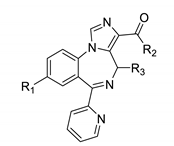
| Entry | Name | R1 | R2 | R3 CH3 | KOR 1 % | MOR 1 % | DOR 1 % | BZR 1 % |
KOR (Ki, nM) |
BZR (Ki, nM) |
|---|---|---|---|---|---|---|---|---|---|---|
| 1 | MP-II-068 | HC≡C | iPrO | H | 85 | 0 | 34 | 97 | 550 | 42 |
| 2 | GL-II-06 | Br | EtO | (R) | 79 | 11 | 9 | 81 | 401 | 556 |
| 3 | Hz-166 | HC≡C | EtO | H | 60 | 6 | 49 | n.d. | 3821 | n.d. |
| 4 | GL-II-19 | HC≡C | EtO | (R) | 44 | 17 | 2 | 71 | - 2 | 1143 |
| 5 | MP-III-024 | HC≡C | MeO | H | 43 | 0 | 24 | 81 | - 2 | 277 |
| 6 | GL-II-32 | HC≡C | MeO | (R) | 35 | 32 | 0 | 63 | - 2 | 1427 |
| 7 | GL-II-31 | HC≡C | MeHN | (R) | 23 | 17 | 3 | 72 | - 2 | 1697 |
| 8 | GL-II-51 | Br | HO | (R) | 11 | 0 | 0 | 84 | - 2 | 181 |
| 9 | SR-II-54 | HC≡C | HO | H | 9 | 8 | 1 | 80 | - 2 | 69 |
| 10 | GL-II-30 | HC≡C | HO | (R) | 0 | 20 | 4 | 65 | - 2 | 431 |
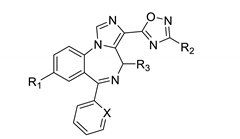
| Entry | Name | R1 | R2 | R3 | X | KOR 1 % | MOR 1 % | DOR 1 % | BZR 1 % |
KOR (Ki, nM) |
BZR (Ki, nM) |
|---|---|---|---|---|---|---|---|---|---|---|---|
| 1 | GL-I-81 | HC≡C | iPr | (S) | C-F | 93 | 64 | 25 | 83 | 127 | 839 |
| 2 | MP-IV-010 | HC≡C | iPr | (R) | C-F | 94 | 33 | 5 | 64 | 145 | 814 |
| 3 | GL-I-66 | HC≡C | Et | (S) | C-F | 92 | 28 | 2 | 80 | 212 | 654 |
| 4 | GL-I-65 | HC≡C | Me | (S) | C-F | 88 | 2 | 7 | 79 | 222 | 1147 |
| 5 | GL-IV-03 | c-Pr | Et | (R) | C-F | 91 | 25 | 67 | 65 | 232 | n.d. |
| 6 | GL-III-60 | Br | Me | (R) | C-F | 87 | 26 | 18 | 100 | 232 | 784 |
| 7 | MP-IV-004 | HC≡C | Me | (R) | C-F | 86 | 7 | 10 | 63 | 444 | 1079 |
| 8 | GL-II-54 | HC≡C | Et | (R) | N | 80 | 0 | 0 | 66 | 504 | 2037 |
| 9 | GL-III-63 | c-Pr | Me | (R) | C-F | 78 | 8 | 31 | 28 | 678 | - 2 |
| 10 | GL-III-64 | c-Pr | Me | (R) | N | 60 | 7 | 14 | 92 | 2048 | 1490 |
| 11 | MP-III-085 | HC≡C | Me | H | N | 40 | 0 | 0 | 82 | - 2 | 357 |
| 12 | MP-III-080 | HC≡C | Et | H | N | 47 | 0 | 0 | 88 | - 2 | 303 |
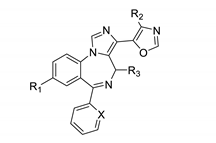
| Entry | Name | R1 | R2 | R3 | X | KOR 1 % | MOR 1 % | DOR 1 % | BZR 1 % |
KOR (Ki, nM) |
BZR (Ki, nM) |
|---|---|---|---|---|---|---|---|---|---|---|---|
| 1 | SH-I-85 | Br | H | H | C-F | 91 | 16 | 33 | 99 | 162 | 11 |
| 2 | GL-III-76 | Br | H | (S) | C-F | 83 | 3 | 0 | 100 | 221 | 120 |
| 3 | GL-III-36 | Br | H | (R) | C-F | 88 | 0 | 12 | 86 | 246 | 319 |
| 4 | KRM-II-18B | HC≡C | H | H | C-F | 89 | 11 | 20 | 97 | 361 | 38 |
| 5 | KRM-III-59 | Br | Me | H | C-F | 73 | 0 | 11 | 96 | 408 | 20 |
| 6 | GL-III-73 | HC≡C | H | (R) | C-F | 74 | 12 | 4 | 65 | 449 | 602 |
| 7 | GL-III-78 | HC≡C | H | (S) | C-F | 74 | 10 | 9 | 101 | 451 | 261 |
| 8 | KRM-II-73 | Br | H | H | C-H | 83 | 11 | 32 | 97 | 736 | 45 |
| 9 | KRM-III-66 | Br | Me | H | C-H | 67 | 12 | 11 | 86 | 756 | 49 |
| 10 | KRM-III-65 | HC≡C | Me | H | C-F | 64 | 0 | 16 | 96 | 879 | 45 |
| 11 | KRM-II-82 | HC≡C | H | H | C-H | 78 | 5 | 20 | 95 | 1203 | 96 |
| 12 | KRM-II-97 | Br | H | H | N | 62 | 18 | 8 | 93 | 1959 | 140 |
| 13 | KRM-III-67 | HC≡C | H | H | N | 48 | 30 | 3 | 71 | - 2 | 144 |
| 14 | KRM-II-81 | Br | Me | H | N | 46 | 7 | 15 | 86 | - 2 | 294 |
| 15 | KRM-III-79 | HC≡C | Me | H | N | 9 | 32 | 1 | 81 | - 2 | 308 |
© 2020 by the authors. Licensee MDPI, Basel, Switzerland. This article is an open access article distributed under the terms and conditions of the Creative Commons Attribution (CC BY) license (http://creativecommons.org/licenses/by/4.0/).
Share and Cite
Li, G.; Nieman, A.N.; Mian, M.Y.; Zahn, N.M.; Mikulsky, B.N.; Poe, M.M.; Methuku, K.R.; Liu, Y.; Cook, J.M.; Stafford, D.C.; et al. A Structure-Activity Relationship Comparison of Imidazodiazepines Binding at Kappa, Mu, and Delta Opioid Receptors and the GABAA Receptor. Molecules 2020, 25, 3864. https://doi.org/10.3390/molecules25173864
Li G, Nieman AN, Mian MY, Zahn NM, Mikulsky BN, Poe MM, Methuku KR, Liu Y, Cook JM, Stafford DC, et al. A Structure-Activity Relationship Comparison of Imidazodiazepines Binding at Kappa, Mu, and Delta Opioid Receptors and the GABAA Receptor. Molecules. 2020; 25(17):3864. https://doi.org/10.3390/molecules25173864
Chicago/Turabian StyleLi, Guanguan, Amanda N. Nieman, Md Yeunus Mian, Nicolas M. Zahn, Brandon N. Mikulsky, Michael M. Poe, Kashi R. Methuku, Yongfeng Liu, James M. Cook, Douglas C. Stafford, and et al. 2020. "A Structure-Activity Relationship Comparison of Imidazodiazepines Binding at Kappa, Mu, and Delta Opioid Receptors and the GABAA Receptor" Molecules 25, no. 17: 3864. https://doi.org/10.3390/molecules25173864
APA StyleLi, G., Nieman, A. N., Mian, M. Y., Zahn, N. M., Mikulsky, B. N., Poe, M. M., Methuku, K. R., Liu, Y., Cook, J. M., Stafford, D. C., & Arnold, L. A. (2020). A Structure-Activity Relationship Comparison of Imidazodiazepines Binding at Kappa, Mu, and Delta Opioid Receptors and the GABAA Receptor. Molecules, 25(17), 3864. https://doi.org/10.3390/molecules25173864









